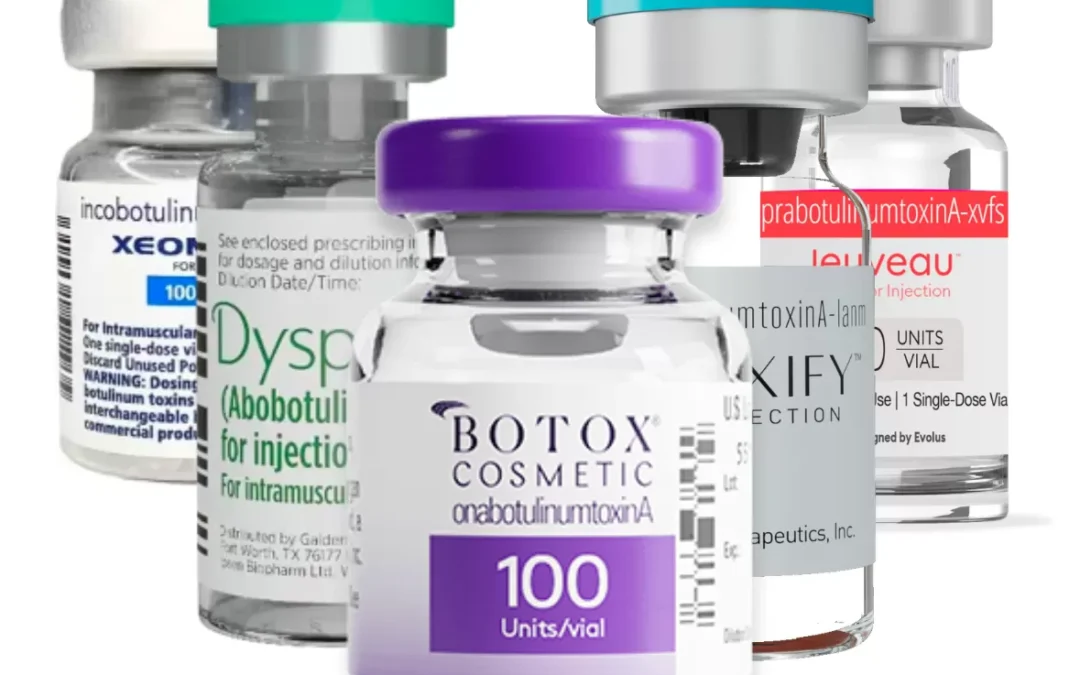At Simply Bliss Medical Spa, we’re dedicated to helping you achieve a refreshed, youthful look with the latest and safest treatments. Among our most sought-after services are neurotoxin injections—proven, minimally invasive solutions for smoothing fine lines and wrinkles.
When we say “Botox,” remember it’s actually a brand name—just one of several highly effective neurotoxins available today! Let’s explore the differences and unique benefits of Botox, Daxxify, Dysport, and Jeuveau, so you can choose the best fit for your needs.
In this comprehensive blog, we’ll explain what neurotoxins are, how they work, the unique features of each brand, and what you can expect from your treatment at Simply Bliss.
What Are Neurotoxins?
Neurotoxins are purified proteins that temporarily relax facial muscles responsible for dynamic wrinkles—those caused by repeated expressions like frowning, squinting, or smiling. When expertly injected, neurotoxins soften lines and prevent new ones from forming, leaving your skin looking smoother and more youthful without changing your natural expressions.
How Do Neurotoxin Injections Work?
Neurotoxins such as Botox, Daxxify, Dysport, and Jeuveau block the release of acetylcholine—a neurotransmitter that signals muscles to contract. By interrupting this signal, targeted muscles relax, and the overlying skin appears smoother. The effects are temporary, typically lasting from 3 to 6 months depending on the product and individual metabolism.
Our Featured Neurotoxin Brands
- Botox®: The original and most widely recognized neurotoxin, FDA-approved for cosmetic use since 2002. Botox is trusted for its safety, predictability, and versatility in treating forehead lines, crow’s feet, frown lines, and more.
- Daxxify®: A next-generation, long-lasting neurotoxin that may provide results for up to 6 months or longer. Daxxify uses a unique peptide stabilizer, offering a new option for those seeking extended wrinkle reduction.
- Dysport®: Known for its quick onset and ability to spread slightly more than other brands, Dysport is often preferred for larger treatment areas like the forehead. Results may appear as soon as 2–3 days after injection.
- Jeuveau®: The newest FDA-approved neurotoxin, sometimes called “Newtox.” Jeuveau is specifically designed for cosmetic use and is a popular choice for treating glabellar (frown) lines.
What Can Neurotoxins Treat?
- Forehead lines
- Crow’s feet (around the eyes)
- Frown lines (between the eyebrows)
- Bunny lines (nose wrinkles)
- Chin dimpling
- Neck bands
- Downturned mouth corners
- Gummy smile
What to Expect During Your Visit
Your Simply Bliss experience begins with a personalized consultation. Our expert injectors assess your goals, facial anatomy, and muscle movement to create a tailored treatment plan. The injection process is quick (often under 15 minutes) and involves minimal discomfort—most clients compare it to a tiny pinch. There’s little to no downtime, and you can return to normal activities right after your appointment.
When Will I See Results and How Long Do They Last?
- Botox: Results appear in 3–7 days and last 3–4 months.
- Daxxify: Results may appear in 1–2 days and can last 6 months or longer.
- Dysport: Results may be visible in 2–3 days and last 3–4 months.
- Jeuveau: Results typically appear in 2–5 days and last 3–4 months.
Are Neurotoxin Injections Safe?
All neurotoxins used at Simply Bliss are FDA-approved and have undergone extensive clinical testing for safety and efficacy. Side effects are generally mild and temporary, such as slight redness, swelling, or bruising at the injection site. Serious complications are rare when injections are performed by trained professionals.
Fun Fact About Botox
Did you know? Botox was first used in the 1980s to treat eye muscle disorders before its wrinkle-smoothing benefits were discovered. Today, millions of people worldwide trust neurotoxins for both cosmetic and medical uses!
Why Choose Simply Bliss for Your Neurotoxin Treatments?
- Comprehensive Options: We offer all leading neurotoxin brands so you can choose the best fit for your needs.
- Expertise: Our injectors are highly trained in facial anatomy and advanced techniques, ensuring natural-looking, beautiful results.
- Personalized Care: Every treatment is tailored to your unique features and goals.
- Comfort & Safety: We prioritize your comfort, safety, and satisfaction at every step.
LET’S ANSWER YOUR FREQUENTLY ASKED QUESTIONS!
Can I combine neurotoxins with other treatments?
Yes! Neurotoxins pair well with fillers, lasers, and skincare for a complete rejuvenation plan.
Will I look frozen?
When administered by skilled injectors, neurotoxins soften lines without freezing natural expression.
How often will I need treatments?
Most clients schedule maintenance every 3–6 months depending on the product and their goals.
Experience the Simply Bliss Difference
If you’re ready to smooth wrinkles and refresh your look, book your neurotoxin consultation at Simply Bliss today! Call us at 402-502-9868!
- Disclaimer: Results may vary. Neurotoxin injections should be performed by trained professionals. Always follow aftercare instructions for best results.
References
- Alam, M., et al. (2021). “Aesthetic Use of Botulinum Toxin: Updated Evidence-Based Recommendations.” Dermatologic Surgery, 47(2), 197–212.
- Fabbrocini, G., et al. (2018). “Safety and Efficacy of Botulinum Toxin Type A in Cosmetic Dermatology: A Systematic Review.” Journal of Cosmetic Dermatology, 17(3), 381–388.
- Moers-Carpi, M., et al. (2021). “DaxibotulinumtoxinA for Injection (DAXXIFY) in the Treatment of Glabellar Lines: Results from SAKURA 1 and SAKURA 2.” Journal of the American Academy of Dermatology, 85(2), 477–487.
- Rubin, M. G., et al. (2009). “Dysport and Botox: A Double-Blind, Randomized, Split-Face Study in the Treatment of Glabellar Lines.” Dermatologic Surgery, 35(5), 732–738.
- Cohen, J. L., et al. (2019). “Efficacy and Safety of PrabotulinumtoxinA (Jeuveau) in the Treatment of Glabellar Lines: Results from Two Phase III Clinical Trials.” Journal of Drugs in Dermatology, 18(1), 36–44.



No responses yet